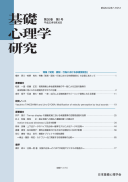Volume 11, Issue 2
Displaying 1-13 of 13 articles from this issue
- |<
- <
- 1
- >
- >|
-
Article type: Cover
1993 Volume 11 Issue 2 Pages Cover5-
Published: March 31, 1993
Released on J-STAGE: November 12, 2016
Download PDF (21K) -
Article type: Cover
1993 Volume 11 Issue 2 Pages Cover7-
Published: March 31, 1993
Released on J-STAGE: November 12, 2016
Download PDF (43K) -
Article type: Article
1993 Volume 11 Issue 2 Pages 75-86
Published: March 31, 1993
Released on J-STAGE: November 12, 2016
Download PDF (1440K) -
Article type: Article
1993 Volume 11 Issue 2 Pages 87-101
Published: March 31, 1993
Released on J-STAGE: November 12, 2016
Download PDF (2016K) -
Article type: Article
1993 Volume 11 Issue 2 Pages 103-111
Published: March 31, 1993
Released on J-STAGE: November 12, 2016
Download PDF (1064K) -
Article type: Article
1993 Volume 11 Issue 2 Pages 113-118
Published: March 31, 1993
Released on J-STAGE: November 12, 2016
Download PDF (858K) -
Article type: Article
1993 Volume 11 Issue 2 Pages 119-122
Published: March 31, 1993
Released on J-STAGE: November 12, 2016
Download PDF (476K) -
Article type: Article
1993 Volume 11 Issue 2 Pages 128-
Published: March 31, 1993
Released on J-STAGE: November 12, 2016
Download PDF (186K) -
Article type: Article
1993 Volume 11 Issue 2 Pages 128-
Published: March 31, 1993
Released on J-STAGE: November 12, 2016
Download PDF (186K) -
Article type: Article
1993 Volume 11 Issue 2 Pages 128-
Published: March 31, 1993
Released on J-STAGE: November 12, 2016
Download PDF (186K) -
Article type: Article
1993 Volume 11 Issue 2 Pages 128-129
Published: March 31, 1993
Released on J-STAGE: November 12, 2016
Download PDF (323K) -
Article type: Article
1993 Volume 11 Issue 2 Pages 129-
Published: March 31, 1993
Released on J-STAGE: November 12, 2016
Download PDF (188K) -
Article type: Article
1993 Volume 11 Issue 2 Pages 129-
Published: March 31, 1993
Released on J-STAGE: November 12, 2016
Download PDF (188K)
- |<
- <
- 1
- >
- >|
